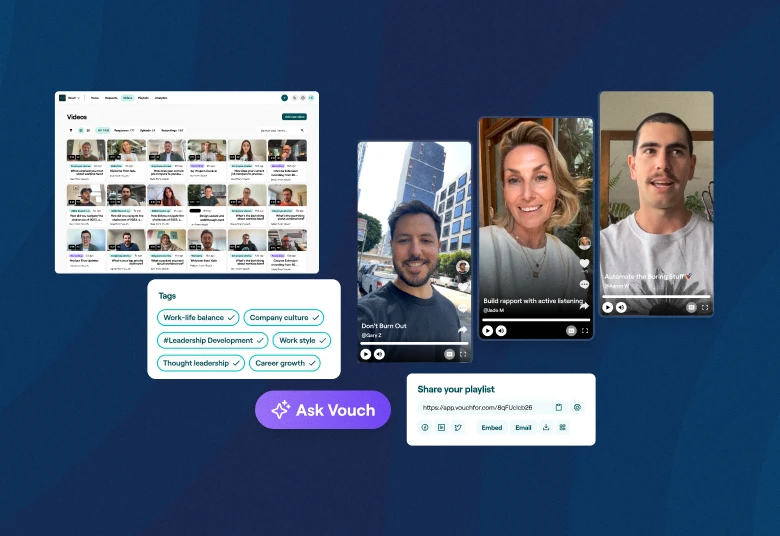Would you like to know how your team is feeling on a weekly or monthly basis?
A company or "team temperature check" is an easy way to assess your team's overall well-being and satisfaction - all vital for building a strong employer brand.
This temperature check helps your team voice their concerns, provide feedback, and feel heard by the leadership.
There are a lot of benefits, so let's dive in!
Key Highlights
Conducting a team temperature check helps you understand your employee satisfaction and your workplace culture.
- By regularly checking in with your team, you can address any challenges and promote a positive work environment.
- Survey questions can help measure employee morale, identify significant challenges, and gather feedback for improvement.
- Modern video tools like Vouch can help you gather all kinds of employee feedback and testimonials.
Why Perform Team Temperature Checks?
A company temperature check is used to engage your employee's happiness.
Of course, your team's happiness is crucial to a productive, collaborative workplace culture.
Let's dive a little deeper:
1) A company temperature check helps gauge employee satisfaction and well-being.
2) A team temperature check allows you to identify any significant challenges or obstacles that team members may be facing.
3) A team temperature check gives you insight into areas of workplace culture, communication, and leadership that can be improved.
4) This proactive survey approach can also go a long way to promoting employee retention and engagement.
Bring your employer brand to life
- Empower employees’ storytelling
- Transform careers sites with video
- AI-driven video editing
- Publish videos anywhere

When Do You Use Team Temperature Checks?
The team temperature check can be used weekly or as needed, depending on the dynamics, size of your team, and, of course, workload.
In smaller teams, you can use the team temperature check (below) at the end of a week, fortnightly, or even monthly to gather feedback on the team's experiences and feelings.
At Vouch, we love checking in weekly, and we use Vouch video to make the check-ins really easy!
But by conducting the team temperature check on a regular basis, you can make any necessary adjustments to best support your team and show them you care.
Remember, the goal of the team temperature check is to actively listen to your team members, address any issues, and promote a sense of inclusion and engagement.
It's important to create a safe space where team members feel comfortable sharing their thoughts and concerns.
5 Brilliant Company Temperature Check Questions
Here are five brilliant team temperature check survey questions that can provide valuable insights into your team's satisfaction and well-being.
And remember, tools like Vouch are perfect for streamlining team communications, especially for team temperature checks!
Q1. From 1-10 (with 10 being amazing), how has your week been?
This question provides an overall gauge of your employee's morale.
Here are some points to consider when analyzing the responses to this question:
- Higher ratings indicate a positive week with high morale and satisfaction.
- Lower ratings, of course, may indicate challenges or issues that need to be addressed, like work-life balance.
- Consistent high or low ratings across the team may indicate a pattern or specific areas for improvement.
Q2. What was your single biggest challenge this week?
Another vital question to ask is the team members' single most significant challenge during the week.
This question allows team members to identify specific obstacles or difficulties they have encountered and provides an opportunity for support or problem-solving.
Let's go a little deeper into why this "biggest challenge" question matters:
- This questions helps you prioritize support and resources for team members.
- Commonly recurring challenges among team members may indicate areas for process improvement or additional training.
- Addressing these challenges can help alleviate stress and increase overall productivity.
Q3. Did you solve your biggest challenge?
Following the question about the biggest challenge, this question allows you to understand "how" team members were able to overcome their difficulties.
Did they do this independently, or did they require additional support or resources?
Here are some bullet points to consider when analyzing the responses to this question:
- Positive responses indicate that team members were able to find solutions to their challenges.
- Negative responses may require further investigation to identify any barriers to problem-solving.
- Try to read between the lines, as unresolved challenges can reduce a team member's confidence and job satisfaction.
Q4. What could we do better next week?
This question allows team members to suggest ways in which the leadership or their coworkers can provide support or assistance.
Here are some answers to look out for, and again, you may need to read between the lines as some employees may not be so forthcoming:
- Team members may suggest specific actions or resources that would be helpful in overcoming challenges or improving work processes.
- Addressing the suggestions can create a sense of collaboration and support within the team.
- Encouraging team members to provide input on how they can be supported can increase their sense of ownership and job satisfaction.
Q5. Do you have any other feedback that will help us improve?
This question helps capture any issues that may fall between the cracks.
Here are some answers to pay special attention to:
- Team members may provide feedback on communication, processes, work environment, or any other aspect that can be improved.
- Addressing the feedback can lead to continuous improvement and increased employee satisfaction.
- Encouraging open and honest feedback can create a culture of trust and collaboration within the team.
Should You Follow Up Your Weekly Company Temperate Checks?
Absolutely, following up on every employee survey is vital!
You need to address any issues, track progress, and show employees that their feedback matters.
Consistent employee survey follow-ups can lead to improved communication, problem-solving, and overall team dynamics.
Further Defining A Team Temperature Check V.S. A Company Temperature Check
The differences between a Team Temperature Check and a Company Temperature Check have some cross overs in the process, so it can be confusing.
Let's dive into the differences so it's really clear for your pulse and temperature checks:
1. Team Temperature Check (Employee focused)
A Team Temperature Check focuses on understanding the morale, engagement, and overall well-being of a specific team within a company.
The purpose is to gauge how a particular group of employees feels about their work environment, internal communications, leadership, and their current workload.
A team temperature check is more focused approach that enables managers and team leaders to take actionable insights based on the team's feedback.
Key Characteristics:
- Scope: Limited to one team or department.
- Focus: Individual team dynamics, workload, support from leadership, collaboration, and morale.
- Frequency: Often conducted more regularly (weekly, biweekly, or monthly).
- Objective: To identify specific pain points or strengths within a small group, allowing leaders to make adjustments quickly.
- Actionability: Easier to implement immediate changes since it's team-specific.
Example Scenarios:
- Leadership Assessment: How well do team members feel supported by their direct manager?
- Team Collaboration: Are team members feeling they collaborate effectively with each other?
- Workload Balance: Do employees feel their workload is manageable within the team?
2. Company Temperature Check (Wider team focused)
A Company Temperature Check is broader in scope and focuses on the overall health and culture of the organization.
It seeks to capture feedback on larger issues that impact the entire company, such as corporate values, leadership vision, company-wide policies, and your overall employee engagement.
Key Characteristics:
- Scope: Covers the entire organization.
- Focus: Company-wide culture, leadership, employee engagement, communication across all departments, and organizational changes.
- Frequency: Typically conducted quarterly, semi-annually, or annually.
- Objective: To assess the general sentiment across the company and to identify patterns that might require structural or cultural change.
- Actionability: Results can lead to broader, company-wide initiatives, but changes may take longer to implement.
Example Scenarios:
- Leadership Vision: Do employees across the company feel aligned with the executive leadership’s vision?
- Company Culture: Are employees satisfied with the company’s mission, values, and long-term goals?
- Organizational Communication: How effectively is information shared across departments and teams?
Summarizing The Key Differences Between A Team Temperature Check V.S. A Company Temperature Check:
- Granularity: Team checks are specific to one group; company checks provide a bird’s-eye view of the entire organization.
- Speed of Change: Team-level insights allow for faster interventions, while company-level results may require more strategic, long-term solutions.
- Stakeholders: Team checks are often for managers or team leads, while company checks are reviewed by executive leaders or HR departments for larger decision-making.
Both checks serve important purposes, helping you to keep your organization and work environments at both micro (team) and macro (company) levels.
What Else Can You Do To Improve Employee Engagement?
Improving employee engagement is essential for creating a positive work environment and fostering a culture of productivity and collaboration. Here are a few strategies to enhance employee engagement:
- Work on open communication: Create opportunities for open and honest communication within the team. Encourage feedback, suggestions, and ideas from team members, and actively listen to their input.
- Provide growth opportunities: Offer professional development programs, training sessions, or mentorship opportunities to help team members expand their skills and knowledge. This shows that you value their growth and development.
- Recognize and reward achievements: Acknowledge and celebrate the accomplishments of team members. This can be done through small gestures such as a shout-out during team meetings or more formal recognition programs.
- Promote work-life balance: Encourage a healthy work-life balance by providing flexible work arrangements, time-off, or wellness initiatives. This helps prevent burnout and promotes overall well-being.
- Build a positive workplace culture: Foster a culture of trust, respect, and inclusivity. Encourage collaboration, teamwork, and diversity. Create a work environment where team members feel valued, supported, and empowered.
Implementing these strategies can improve employee engagement, enhance team productivity, and create a positive workplace culture.
FAQs
What is a temperature check in business?
A temperature check-in business is a method to gauge the overall health and satisfaction levels of a team. It involves using surveys or assessments to gather feedback on various aspects like morale, communication, and work culture.
What are the benefits of implementing company temperature checks?
By implementing company temperature checks, you can identify issues early on, enhance communication, boost morale, and improve overall productivity. This proactive survey approach can also go a long way to promoting employee retention and engagement.
How Often Should We Conduct Company Temperature Checks?
At Vouch, we love checking in weekly, and we use Vouch video to make the check-ins really easy! However, if you have a smaller team, checking in less often is also extremely powerful.
What Should We Do If We Receive Negative Feedback?
If you receive negative feedback, let the employee know you will investigate straight away and try to solve the issues - and absolutely follow up with the employee asap. Of course, there is always a balance, and different team leaders and HR personnel will have their own styles.
What is a business culture check?
A business culture and temperature check is a diagnostic process used to evaluate the health of an organization's workplace culture. It involves gathering employee feedback on factors like morale, engagement and overall satisfaction.
How can organizations conduct culture checks?
Effective checks involve anonymous surveys, focus groups, or one-on-one interviews to encourage honest feedback. Tools like pulse surveys and employee engagement platforms like Vouch can streamline data collection. Questions should target key areas like leadership effectiveness, team dynamics, and alignment with company values.
Conclusion
Conducting regular team temperature checks is essential for maintaining a positive work environment and fostering employee engagement.
By asking key survey questions and following up on the results, team leaders and HR can gain valuable insights into the team's satisfaction, address challenges, and promote open communication.
Implementing the suggestions provided by team members and actively working towards improving employee engagement can lead to a positive workplace culture and increased productivity. Remember, a team temperature check is a tool for continuous improvement and creating an inclusive work environment where team members feel valued and supported.
Modern tools like Vouch also make it really easy to perform company temperature checks and build your employer brand.
See How Vouch Help With Team Temperature Checks!
Loved by companies like Canva, Nike, Cisco,HubSpot, Amazon, and more, tools like Vouch make leveraging video in your business remarkably easy for team temperature checks.
Be sure to book a Vouch demo today and chat with a video content expert.
You might also like

Elevate Your Brand Today With Vouch
Discover how Vouch can accelerate talent acquisition while helping you stay on-brand.






